WALK AND DON'T LOOK BACK
“I don’t go to contest to make friends. It’s a sign of weakness!”
“I don’t train to impress girls or beat up civilians. I train to compete against bodybuilders!”
– Roger Walker (Bodybuilding Legends Podcast – October 8 2018)
THE ROGER WALKER STORY
This month’s featured bodybuilder is Roger Walker. The first Australian bodybuilder to have a significant impact on the international stage and to many the greatest bodybuilder from ‘The Land Down Under’.
Roger was born in the South of England in 1948. Orphaned at an early age, Roger was taken from his biological parents by the Children’s Services Department. England had a forced adoption practice during these years. Children could be permanently removed from their parent’s custody should they be deemed unfit to care for their offspring. In Roger’s case, these authorities considered his living conditions so poor that this drastic measure was viewed necessary. Over 90% of children forcibly adopted during the time came from families that lived below the poverty line. The plan was to rehome these children with caring middle class families. Roger, one of eight siblings, was paired up with his 18-month-old sister and put into foster care. Little is known of his other siblings, some of which were also paired up and adopted. Whilst his older siblings remained with his biological parents, Roger and his sister bounced from foster home to foster home until adopted by the Walker family. Roger was a mere three years old at the time and has very little recollection of his early years. He never quite settled into home life. His adopted father, a very bright and intelligent man, suffered mentally from the effects of war. He served in the British Navy and the impact of his tour of duty would haunt him for his lifetime. The consequences of Post Traumatic Stress Disorder (PTSD).
Roger left home and joined the royal marines at the age of 14, something unheard of in today’s society. The trying circumstances and conditions of the militant lifestyle hardened Roger both physically and mentally. The physical regiment of the marines was a perfect grounding for the development of a world class physique. Roger would soon become a standout in the demanding physical education sessions. Copious amounts of activities such as running, swimming and rope climbing were all part of standard strength and conditioning drills. He thrived on this and in his limited spare time, he would practice these physical activities, adding additional exercises such as sit ups, chin ups, push ups and burpees to further improve his athletic and physical capabilities. This would quickly bring him to best in class and surpassed the efforts of all including the physical exercise instructor.
At the age of 15, with a sound foundation and mind set, Roger took the first steps into his weight training journey. He encouraged others within his group of cadets to pool what limited funds they had to acquire some basic, primitive weight training equipment. A chest expander being the prize of the outlay. While his fellow investors soon lost interest, Roger’s drive intensified, and he soon had the contraptions solely to himself. His internal motivation was strong and he wanted to become a bodybuilder. He set a goal that he kept to himself, not daring to share it with anyone, considering how ludicrous it seemed, and that was to one day be Mr Universe.
A few years passed and at the age of 17, with limited instruction and negligible access to equipment he was well on his way. 170 pounds on a solid frame, the combination of the Armed Services compulsory physical training and his extra-curricular efforts were equating to some impressive and impactful visual changes. He was building a strong foundation that would pay dividends down the track.
After a couple of more years of solid but haphazard training, primarily within the confines of the limited military base gym, he would compete in his very first competition. Roger was 19 at the time. Without the revelations of the pages of the muscle magazines or having any other guidance from an experienced mentor, Roger crudely stumbled through his preparation and the competition. With little posing ability, at a weight of approximately 190lbs, Roger would finish fourth in this his first contest, the Novice division of the 1967 Mr South East Britain. He was now on his way. A few months later he entered the South Britain Novice competition and again finished fourth. This contest was an unquestionable step up, a number of notches above the calibre of the first contest. Roger’s recollections of both these events are vague and I have not been able to find magazine reports on either to expand beyond this. But what we do know is that one contest was run by Wag Bennett and the other by John Bubb. Roger still has the trophy from his first contest. It has a certain amount of sentimental value. He definitely got a fantastic kick from both these events and was keen for more.
Unfortunately, Rogers competitive career was then put on hold for a couple of years. He was deployed on active service. He was stationed on H.M.S. Hermes, an aircraft carrier vessel, deployed to sea. Roger was part of the ships Operational Band as a clarinet player.
Whilst deployed Roger ensured that his training would not cease. He acquired some basic equipment as part of his personal allotted belongings. An All-In-One Hercules Home Gym from the pages of Health & Strength would be the prized purchase. At a cost of 20 pounds, the investment incorporated adjustments and attachments to enable the completion of preacher curls, flat bench presses, incline presses, shoulder presses, squats and dips. A ship mate had dubiously come across some stainless-steel bar and sold it to Roger, who then got it cut to size. Roger had now added a barbell and dumbbells to his collection. Fortunately, the ship was equipped with numerous 20lbs plates. Roger added to these whilst docked at Cape Town where he bought four Weider 50lb plates. Weider equipment was never known for quality and each plate varied anywhere from 48 to 54lbs!
Initially Roger set the gym up in the chain locker, a forward component in the lower part of the ship where the anchor is kept. The problem with this is that he would be showered continuously whilst training. Water would gush from the hawse pipe making training impossible. He then moved to the Seacat missile deck which was open to the elements. This didn’t prove much better. As space was limited, he ultimately jammed his makeshift gym between two lockers down near the bows of the ship. Not to be deterred, he trained under inconceivable conditions. All his training was done to the moving motion of the vessel with the weights varying up to and beyond a hundred pounds with the shifts in the sea. Further, the ship used diesel fuel as ballast to lower its centre of gravity and increase stability. Roger would have to train with two to three inches of fuel under his feet at all times and the air was eternally filled with the smell of the diesel fuel. Roger would end training session in a coughing fit from the smell. These conditions made training extremely difficult at best, dangerous as a rule and close to impossible for us mere mortals. Not Roger, he was undeterred but he has confessed to sitting in bed at the end of each day praying for a calm day. A world away from the comforts of todays ‘soft society’ with the modern aspects of the pampered gym environment and culture. Despite the training impediments Roger had one aim, his sole goal and all determination was set on leaving the ship in better shape than he went on. Mission accomplished!
Once back on dry land, Roger would be acquainted with the effervescent and enthusiastic Wag Bennett. He would spend some time training at his Romford Road Gym in London. Wag would have an influential impact on Roger’s early career. He would provide Roger with accommodation and feature him in his magazine ‘Peak Muscle Maker’. Roger would grace the cover of the January 1971 edition.
However, of far greater significance was Roger’s association with Gordon Allen, the Portsmouth Bodybuilding Strongman that initially refined Arnold Schwarzenegger’s physique. It was at his Albert Road Gym in the mid-60s that ‘The Austrian Oak’ was truly introduced to what real training was. Gordon would push Schwarzenegger to breaking point and far beyond anything the ‘wunderkind’ had previously dreamed brutally possible. Roger would now experience the same education.
Gordon Allen was an exceptional regional bodybuilder known for having astonishing strength. Gordon supplemented the dues from his gym by selling schmutter to the sailors that docked at Portsmouth. During one such time, Gordon got wind that there was a bodybuilder aboard a docked ship. Curious, he investigated and that was how he met Roger. After striking up a friendship, Gordon invited Roger to train with him. Roger took advantage of this whenever possible. Allen could see Roger’s drive and potential and their training session would become more frequent and brutal. Gordon, six years Roger’s senior, was very intimidating. Roger was very nervous around him, however in time, this would subside and Gordon would become Roger’s bodybuilding mentor. The only person Roger would ever credit as a coach. His immense knowledge combined with his brutal form of heavy training would help develop Roger’s trademark strength and size. As a by-note it would take Roger three years to match Gordon’s strength before he was able to surpass him on key exercises.
It was also time for the introduction of Dianabol, the bodybuilding ‘wonder drug’ that was par for course for any top-level aspiring bodybuilder of the time. Three tablets daily, only to be used in the last few weeks leading up to a competition, just enough to put the final polish on an already competitive physique.
Under Gordon’s eye, Roger would make his return to competition at the 1971 South East British title. He would finish second to the brash, self-confident Johnny Fuller. Something that didn’t sit well with Roger at the time. With his motivation fuelled, he would return to seek retaliation. In 1972, Roger would win the South East British title turning the tables on Fuller. This victory would qualify Roger for the 1972 NABBA Mr Britain. Roger would finish third in this contest behind Paul Grant and Roy Duval. Two of the premier bodybuilders of the United Kingdom. Later in this same year, Roger would start to hit his straps with victory in both the IFBB Mr United Kingdom and IFBB Mr Britain against stellar big-name opposition. He would outgun such competitors as John Citrone, Bill Trotter, Bill Richardson, Paul White and Trevour Cording amongst others. He was now one of the elites of British Bodybuilding and destined for greater things. Surely it was only a matter of time before he would be the foremost bodybuilder in the British Isles. However, Roger had other thoughts, he was growing tired of England. Sick of what seemed to be never ending rain showers, cloudy skies and wet and windy surrounds, he needed a life changing adjustment. Roger decided to join the Australian Airforce whilst still in England and migrate to Australia. Thus, providing job security before making his move from the motherland to the “Lucky Country”.
In March 1973, Roger would land on Australian shores. The land of sunshine, beaches, inexpensive fresh food and a copious and endless supply of muscle building beef, lamb, chicken and eggs! Heaven on earth in comparison to what England offered. With his move a new era of Australian Bodybuilding was about to commence, with all due respect to the Australian champions of the past. That said, almost unnoticed, this quiet unassuming clarinet player from the United Kingdom slipped into the country with little to no fanfare. However, just as Roger had risen to prominence in his native England, it would not be long before he would find himself at the head of the bodybuilding class in Australia. The valedictorian of Australia’s induction to the world stage of bodybuilding. We finally had someone that could compete with the Americans!
Upon his arrival, Roger would be deployed to the RAAF base in Richmond New South Wales as part of the RAAF Operational Command Band. The clarinet his instrument of expertise. He would remain there until his discharge and move to Melbourne in 1976. But more on this later.
Shortly after arriving in Australian Roger would pay a visit to Melbourne. Roger was to be the guest poser and one of the judges at the 1973 Mr Victoria. This was his introduction to Frank Burwash a critical figure of Australian Bodybuilding. Frank was one of the true gentlemen of Australian Bodybuilding and would go to selfless lengths to advance Australian Bodybuilding and its Bodybuilders on the international stage. Roger also met George Johns, a local bodybuilder, who was competing for the title. George, quietly confident that he would finally win the state title, was thrown into mental turmoil at the sight of Roger pumping up back stage, his dreams of victory shattered. His despair quickly turned to optimism when he discovered why this herculean mystery he-man was backstage. Safe in the knowledge that Roger was not part of his competition, his focus once again returned to his known challenges. George would go on to take the title with a unanimous verdict ahead of Clyde Bird. Roger and George would build a friendship that is still strong today.
The visit would also provide Roger with the opportunity to see the cream of Australian Bodybuilding and weigh up the local competition. Safe in the knowledge that he had the opposition covered, Roger returned to the RAAF base and continued to train. Once again, Roger was handicapped with little to no equipment. With no more than a few huge concrete blocks as weights and a number of crude contraptions fixed to his fence, Roger prepared for his blitz to take the Australian title. Fortunately, he was able to supplement his ‘home gym training’ with visits to Syndey Gyms when the opportunities arose and this is where he first made acquaintance with Paul Graham.
Roger would enter and win the national title, the 1973 Mr Australia held in Brisbane, Queensland. Roger would overcome the challenge of the impressive but highly enigmatic Victorian Clyde Bird, whilst Bill Richardson of Perth would take the third spot. Other notables in the muscle affair included the Victorian, George Johns, South Australian great John Koziura and Paul Graham of New South Wales. Roger didn’t bother entering the next year, for he firmly believed that once you won a title, you proved yourself and should step down and give others a chance. He also set his sights on greater goals, and started training in earnest for the 1974 IFBB Mr Universe.
Around this time, Roger was training on a six-day, double split weekly routine. One body part in the morning and one in the late afternoon. His training was placed either side of his working day. Training was intense and heavy. Standing presses, 5 reps with 300lbs, 3 reps with 330lbs, a bench press of 490lbs and a squat of 660lbs. Roger could curl 100lbs dumbbells. Some exceptional poundage that was clearly reflected in his Herculean physique.
In 1974 Roger would enter and clearly win the Mr Southern Hemisphere and Mr Southern Universe. His good friend George Johns would finish third in the Southern Hemisphere event, which was held at the Ormond Townhall in Melbourne. George would also capture the Best Poser Award. Victories in these two contests would lead to the generous sponsorship of Melbourne Gym owner, Frank Burwash, to compete on the international stage. Frank would provide Roger with an opening to compete at the 1974 IFBB Mr Universe. He would back Roger by paying his way and all associated costs to the contest. He would also do the same in 1975 and 1976. Frank was keen to become involved in the international bodybuilding scene and would become amalgamated with the IFBB. He was one of the very few men in Australian bodybuilding at the time that put in more than he took out. His passion for bodybuilding and its competitors outweighed his own personal gains. He holds a very special place in the evolution of the sport in the country. One that I am keen to explore and share in time.
Now back to the contest which was held in Verona, Italy in October of that year. Roger would finish fourth in the contest. An exceptional result for his first international competition. Joe Weiders “Golden Child” Lou Ferrigno would win Rogers class ahead of Ken Waller and Paul Grant.
In 1975 Roger would enter and win the Mr South Pacific, Mr Australia and Mr Asia. Frank Burwash had granted Roger an exemption from competing in the national title and a free pass into the Asian team for international competitions. Roger, not wanting preferential treatment, declined the proposal. He wanted to earn his trip to South Africa, the same as anyone else and so he entered and won the 1975 Mr Australia ahead of Bill Robertson, Ian Perrott and George Johns. The top 3 competitors in this contest would qualify for the Asian team. This national title was held in Victoria, as back in the day the event democratically rotated from state to state each and every year. The good old days of one title and bodybuilding democracy. A ‘gentleman’s agreement’ unfortunately lost on today’s society of self-interest above the overall good of the masses. Frank Burwash hosted the event at the Melbourne Townhall in front of a wild and enthusiastic packed house of more than 2,700 spectators. At great expense, Arnold Schwarzenegger would be flown in to guest pose, then at the zenith of his bodybuilding career, not that Roger cared.
No sooner had Roger won the national title for the second time, he and the official Australian team were off to Singapore. Frank Burwash was team sponsor, as he had been in 1974, Peter McCarthy was the team manager, whilst Walker, Robinson and Perrett would be the three Australian representatives in Pretoria. George Johns also toured and gained great experience. The team arrived in Singapore a week before the competition and immediately had troubles with the training facilities provided. They found alternative training options much to the disgust of the Singapore officials. The humidity within the country also made conditions challenging. Despite this, Roger won his class with his sheer size, symmetry and proportion ahead of the superb physique of Hideyuki Kosaki of Japan and fellow countryman Bill Robertson. When he was compared to the other class winners, Sonrab Sarabi of Iran and Ronmai Juraim of Singapore, he was a clear and decisive winner.
George Johns also entered the contest as an unregistered competitor. He would unofficially finish 3rd. When made aware of this he confronted Robertson and demanded his 3rd placed trophy. Robertson’s displeasure quickly intensified. Peter McCarthy had separated the two before the ferocity of their rage lead to blows being thrown. I could only assume that Roger enthusiastically settled himself in position to watch the fistic fury that was destined before the timely intervention of makeshift ‘Referee’ McCarthy. Never a dull moment.
Once the dust settled Roger and the team then left Singapore for a week in Manila to do seminars and promotions for television. From there they were off to Hong Kong for a week before heading on to South Africa for their tilt at the IFBB Mr Universe title. A very challenging schedule for one preparing to enter the pinnacle of Amateur Bodybuilding competition. The travel, varied food quality and poor training conditions made it extremely difficult to train at peak intensity. Roger and his team mates arrived in South Africa flat and drained. They arrived in Johannesburg after a long thirty-hour flight, followed by a long bus ride to the final destination of Pretoria. Roger was feeling the pinch, after all the travel and two contests in three weeks, the combination of both was taking a toll.
Once in Pretoria, the Australian team would have several days to acclimatise and prepare for what would be the greatest challenge that they all had faced. The team was based at the resplendent Hotel Burgess Park, and settled in for some much-needed rest. The hotel had first-rate catered food, great service, a beautiful pool, a lawn area to sunbake and most importantly a great gym to train in. The gym was equipped with both Nautilus and conventional equipment. Roger would conduct his workouts alongside Nubret, Robinson, Schwarzenegger, Zane, Ferrigno, Waller and Columbu. Not that this meant anything to Roger, he was there to win and the competition was his enemy.
The 1975 Mr Universe may have been the biggest and best competition to date. Thirty-seven nations were represented in what would be the backdrop for Pumping Iron. Roger would finish second in his class, a mere 3 points behind the American Ken Waller, who would also be bestowed the overall champion. Waller’s exceptional mass, definition and shape, combined with his posing experience gave him the edge. The April 1976 edition of Muscle Builder commented that “Ken Waller, U.S.A., Tall Class winner, had to be in the best shape of his life for a three-point edge over Australia’s impressive Roger Walker.” The July 1976 edition of Muscle Builder in a more comprehensive report described Roger in the following way – “Powerful, broad Walker has the win potential with excellent proportions, muscle size and an athlete’s appearance. His calves and thighs are beyond compare.” Roger was content with the decision in a very close contest. Australia’s greatest ever physique, looked truly massive and gave Waller a real fright. He did beat out arch English rival Paul Grant and the very publicized, yet disproportionate, Mike Katz.
The following year, in 1976 Roger would win his class at the Mr Universe Contest distinctly out pointing D’arcy Beckles of Barbados to fulfill his boyhood dream. The contest report within the MuscleMag International Annual 2 (1977) describes Roger in the following way – “Walker had good proportions, but lacking definition. It must have been his impressive bulk and muscularity that influenced the judges”. Despite this less than flattering critique, Roger was a clear 11-point winner of his class. The USA would win the overall title with the marvellous physique of Robby Robinson being elected the best of all. Robby won his class ahead of fellow American Mike Mentzer who elected to cut down below the heavyweight limit.
Roger may have been a step or two behind his optimal condition for this show and this was unquestionably attributable to his lead up. Prior to the contest, he was still in the Australian Airforce and the standard protocol each year was to apply for special leave to prepare for and attend the contest. In 1974 and 1975 Roger had been granted such leave on application with no problem or concern. However, this was not the case in 1976. With his request declined Roger went absent without leave. The consequence of multiple infractions was a 3-week period of solitary confinement. During this time, he was locked up without proper nutrition or the ability to train. It was catastrophic for his preparation. After this, Roger was discharged of his duties and a period of military service that started at the tender age of 14 would come to an abrupt end. Roger now had a mere three months to train for the competition. These infractions and the resulting consequences had severely impacted his pre-contest preparation. Upon discharge, he moved to the Melbourne suburb of Nunawading and commenced work at one of Frank Burwash’s gyms as a gym instructor.
Ultimately, the solitary confinement, military discharge and relocation to Melbourne, had a bearing on his preparation and it was ultimately not as good as he wanted it to be. He was not in peak condition, probably a touch below the previous year. But he won. Walker was big at 220lbs and it was this size that was the critical factor that won him the title. He became the first Australian to win the Mr Universe title. Now for the Olympia!
The victory in the Mr Universe qualified Roger for the 1977 Mr Olympia. Before a crowd of 5,000 screaming fans at the Columbus Ohio’s Veterans Memorial Auditorium, he would ultimately place ninth and at the rear of this elite field of muscle stars. A bit player to the professional and polished Frank Zane. However, this position was more down to his approach rather than his work rate, genetic gifts or ability. Roger would listen to the advice of others and look to go away from his strengths. He was advised that he needed to be lean and cut for this contest. His strengths of a full, balanced and symmetrical physique with separated muscles suffered as a result. This aside, it was a big jump from the Mr Universe to the Mr Olympia. The experience was worth more than any numerical placing.
With this experience under his belt Roger headed back to his homeland a wiser competitor. He was never tempted to set up camp in America and declined the opportunity to relocate to the ‘Mecca of Bodybuilding’. The lifestyle and culture at Golds Gym did not align with him or his values. With this, the opportunities to be featured in Weider Publications and compete at the highest level in ongoing American competitions was next to non-existent. Without the push he was totally reliant on his work ethic and natural gifts. Joe wasn’t going to promote a guy on the other side of the world. Roger would have to continue to improve year on year.
We now come to 1978. Roger would have the experience of the 1977 Mr Olympia to make the necessary changes to put him in the mix. Frank Zane would capture his second Mr Olympia crown. Robby Robinson would finish second and Roy Callender third. A disappointed and angered Kalman Szkalak, the fifth placed finisher, expressed his disappointment with the now infamous “Nailed to the Cross!” pose. Whilst Roger would finish last in his class, he nonetheless showed the necessary improvement for future success. Roger was harder, bigger and more defined than prior years but was still considered outclassed somewhat at this level of competition. But the signs were good. Dr Walczak was quoted as saying “If I had him for six months, I would get him in top condition. He could be unbeatable….”
The improvement continued as Roger refined his physique further in 1979 in anticipation of another Olympia tilt. Zane, once again would prove to dominate for the competition and would deservedly win his third Olympia title. Roger was one of five competitors in the over-200lbs class. He would ultimately finish 3rd in his class and the improvement year on year was still noticeable. He was now definitely in the mix with the best of the IFBB world of bodybuilding. He was honing his physique with adjusted improvements to his training and diet that only comes from experience and time. The comment in the Muscle and Fitness contest report summed it up: “Roger Walker – Big, plenty of mass. With a little more international experience, look out!” Roger would end up with a score of 283 points. The equal of Dennis Tinerino and Chris Dickerson. He would be excluded from the final pose down in preference of these two gentlemen and officially finish 7th in the event, equal 5th on points.
The other point of note that occurred at Columbus was that Paul Graham was elected IFBB Vice President of the Oceania South Pacific region (Graham was already President of the Australian Amateur Bodybuilding Federation) and would be granted the right to stage the 1980 Mr Olympia on the 4th October in Sydney, Australia. Great news you would think for the Australian Roger Walker. Unfortunately, Roger and Paul had a falling out earlier in the year which many believe would have an impact on his chances in front of his home audience. Roger moved back to Sydney from Melbourne at Paul Graham’s request in early 1979. He was promised both sponsorship and remuneration for his services and employ. Unfortunately, this didn’t eventuate to a level sustainable for Roger to adequately support his family. Roger left Paul’s employ and things between the two regressed from there. The bitterness remains to this day.
Paul Graham was also granted the right to host the 1979 IFBB Professional Mr Universe. A rehearsal or dry run for what was to come. The pre-judging was held at the Revesby Workers Club with the evening show being presented at the magnificent and world-famous Sydney Opera House. The venue for the 1980 Olympia. Roy Callender would win the show ahead of other internationals Albert Beckles and Tony Emmott. Australia’s representative, the underrated but incredibly muscular, Ivan Djirlic, would finish sixth. Roger was noticeable by his absence. He did not receive an invite. The bitterness between Paul and Roger precluded him the opportunity to add the Professional Mr Universe title to his amateur crown. That said, in the lead up to the 1979 Mr Olympia, Ivan Djirlic did win the 1979 Mr South Pacific, in a hotly contested final against Roger Walker. The decision to award Ivan the title was not without controversy as many thought the shorter, more massive and well-defined Walker was the winner. Ivan did put it all together on the night whilst reports indicated that Roger was perhaps seven pounds from his true form that he would present at the aforementioned Mr Olympia.
Notwithstanding any issues with Paul Graham, Roger would hit his peak at the Mr Olympia on the 4th October 1980. He would stand tall with the best array of bodybuilders ever assembled on one stage. The contest was wide open and the competition was of the highest calibre. Roger was definitely in the mix for a top three placing with at least eight others who presented their own unique form of perfection. I won’t go into the controversy and circumstances of the event and won’t dwell on this aspect of the competition. For that, I recommend you reference “Once Upon a Time in Australia”. As for Roger Walker, he presented the historical best version of himself, despite suffering a painful nerve injury to his arm that hampered his training in the month leading up to the event.
Now for what the magazines had to say. Jack Neary in the February 1981 edition of Muscle and Fitness stated “Unquestionable the most improved bodybuilder in the contest. Thick and striated beyond description, this hometown favourite drew (understandably) the biggest ovation of the day. Walker was very definitely Mr Olympia material.” Bill Reynold added in Paul Graham’s Australasian Muscle and Fitness “Roger Walker would ultimately finish sixth, and I could visualise him as being as high as third, even though the judges didn’t see it that way. Roger improved significantly on the pervious years Olympia. Roger has one of the best backs I’ve ever seen, with both thickness and cuts to rival anyone.” Others stated that Roger, who looked in the best shape of his career, was standing alongside Arnold in the final pose down and compared quite favourably to him in many of the poses. Roger received a tremendous reception from his hometown crowd.
I would like to add what fellow competitor Danny Padilla had to say about the competition on John Hansen’s splendid “Bodybuilding Legends Podcast”. Although Danny had no issue with Arnold Schwarzenegger taking the crown as the “champion gets a free round”, he stated that “the guy that surprised me the most was Roger Walker! He was big like we have never seen before. He had a little bit of lines and he looked pretty much, you know, very competitive. The guy that came closer than anybody was Roger Walker! (to winning the title)”.
Some very favourable assessments to say the least.
In August 1981 Roger would fly down to Melbourne from Sydney for a seminar at Frank Burwash’s Lifestyle Fitness Centre in Dandenong Victoria. A week later he would be a surprise competitor at the PBBI 1981 Mr East Coast. A move that would shock the local competition. Pre-contest favourite, Milton Hatzigeorgiou, threatened to walk out on the contest, throwing promoters Rocco Oppedisano and Frank Burwash into a spin. The promoters had kept Roger’s entry a secret as not to scare off any competitors. Cooler heads finally prevailed and all the PBBI professionals agreed to compete despite being disgruntled by the supposed late entry. The crowd wasn’t so kind, the wild and hot-blooded supporters of the popular local cab driver, Milton Hatzigeorgiou, booed Roger as he came out to pose hurling abuse at him in their native tongue. It all added to the colour of the event. Unaffected and humoured by his reception, Roger posed with a fixed smile on his face. There’s nothing like a crowd of passionate and animated Greeks to add spice to any event. Once the dust settled, Roger clearly superior, would be adjudicated the winner of the competition and all the body part categories. For his trouble, he collected a handy thousand-dollar cash prize. A neat little hit out for the 1981 Mr Olympia!
There was fallout resulting from the perceived circumstances and the set of events that lead to the “Austrian Oak” winning his 7th Olympia title. A number of competitors would boycott the 1981 Mr Olympia. Zane, Coe and Mentzer amongst the leading competitors. Roger would in fact receive a call from Boyer Coe to boycott the contest. Roger wasn’t in the same position as some of the established stars and both needed to and wanted to compete. He had limited exposure outside Australia and the competition was required to enhance his reputation. Roger would finish tenth in the event behind the controversial winner Franco Columbu. I’m not quite sure why his placing was so low as he still presented an excellent version of himself. He was somewhat outspoken about the events in Sydney and maybe this hindered his final placing.
The reviews of Roger’s performance in this contest were mixed. Chris Lund in the January 1982 edition of Bodybuilding Monthly stated, “Roger Walker was heavy and cut. But though his posing was careful and sinuous, he didn’t project…. His physique is tremendous though, a big man who can really get cut, but his posing needs a lot of work and spirit.” Rick Wayne in the April 1982 edition of Muscle and Fitness stated “Roger Walker had been a lot better than he appeared in Columbus”.
Roger also competed in the 1981 IFBB Pro Mr Universe held at the Brighton Le Sans Hotel in Sydney, Australia. Backing up just two weeks after the 1981 Mr Olympia with a great line-up that included such international contestants as Dennis Tinerino, Tony Pearson, Carlos Rodrigues, Hubert Metz, Johnny Fuller, Steve Davis and Don Ross. Australia was represented by Roger Walker and Victorian Graeme Lancefield. Roger would finish second to Dennis Tinerino ahead of Tony Pearson in third. Before the night show, Bill Pearl (Chairman of Judges) stated to Roger that he was ahead at pre-judging. He also informed Roger that an alternate judge would be swapped in as one of the initial judges was ill and could no longer take his place. The change in judges may have very likely effected the final positions. Ultimately, Roger would be beaten by smallest of margins – one point.
Roger would once again compete in a PBBI event in December 1981. He would win the Mr Pacific International ahead of the Graeme Lancefield. Roger was far from his Olympia shape and had only trained for the event for 16 days. Despite this, Roger was a clear winner and would also capture all but two of the body part awards. As a side note, Roger also partnered up with Kim Rogers and place second in the couple’s event losing in a major upset. Kim’s preparation was shorter than usual due to her involvement in the establishment of a new Sydney Gym “Le Club” and their posing presentation wasn’t to the level of the winners. Roger and Kim would appear on the cover of the March 1981 edition of IronMan magazine and also team up the 1981 IFBB World Couples Championships.
1982 would see Roger’s career come to an end. The 1982 Mr Olympia would be his last contest. By finishing in the top ten the previous year Roger was provided with a free passage to London, England for the event. Roger took the ticket but also knew this would be his last contest. He had been battling joint injuries that were making training difficult. The injury had been regressing for the last two to three years and it was time to stop. Roger would end his career at the tail of the field. The magazines were not flattering and the general consensus was that Roger was dramatically off his best. Bob Kennedy stated as such in the May 1983 edition of MuscleMag International “Roger has the structure to be a champion but at this the ’82 Olympia, he was off-form. With proper preparatory advice things could change”. Obviously, Bob was not privy to Rogers accumulating battle with injury.
So, unfortunately there was no fairy tale ending to Rogers Career, but this is usually never the case with elite athletes. However, Roger’s impact on bodybuilding at a national and international level was equal to many of the stars of the golden era of bodybuilding. He is often wrongly overlooked during this magnificent era of the sport. I hope this short piece puts things in perspective.
I would like to thank both George Johns and Roger Walker for providing me their time and recollections. Credit also needs to go to John Hansen and his magnificent series of podcasts. His interview with Roger was a highlight and my inspiration for this piece. Most of the information for this editorial was gathered from an array of articles from my vast bodybuilding magazine collection. In particular, the Australian Muscle Magazines of ‘Muscle Australia’ and ‘Muscle and Fitness Australasia’. Both publishers Rocco Oppedisano and Paul Graham must be praised for their contributions to Australian Bodybuilding. Articles penned by Peter McCarthy and the late Frank Burwash provided great insight and proved to be invaluable to this writing. I also retrieved archived newspaper articles from the Victorian State Library. Many thanks to the librarians for their assistance. I’m hoping that the amalgamation of all these sources has led to a comprehensive and historically accurate account of Roger Walker’s story.
I hope you have enjoyed this article as much as I have putting it together.
In closing, I will share a story that George Johns recently recalled with great fondness. It sums up both the strength and dry wit of Roger Walker. George goes on to explain, “Roger was working at Findlay’s Gym in the late 1970’s. Peter McCarthy managed the gym at the time. There was always a friendly rivalry amongst us all. The gym had some 150lbs globe dumbbells. One day Peter said in passing for all to hear ‘Hey Roger, if you could military press the 150’s for 20 reps I will buy you lunch today!’ Roger, never to back down from a challenge, casually went to the rack and commenced to press the dumbbells in the standing position, rep after rep, with apparent ease before he abruptly stopped and dropped the dumbbells at 19! Peter said ‘I knew you couldn’t do it’ to which Roger answered with a smile ‘I just didn’t want to have lunch with you’. Those watching in amazement broke into boisterous laughter. Those were the days!’
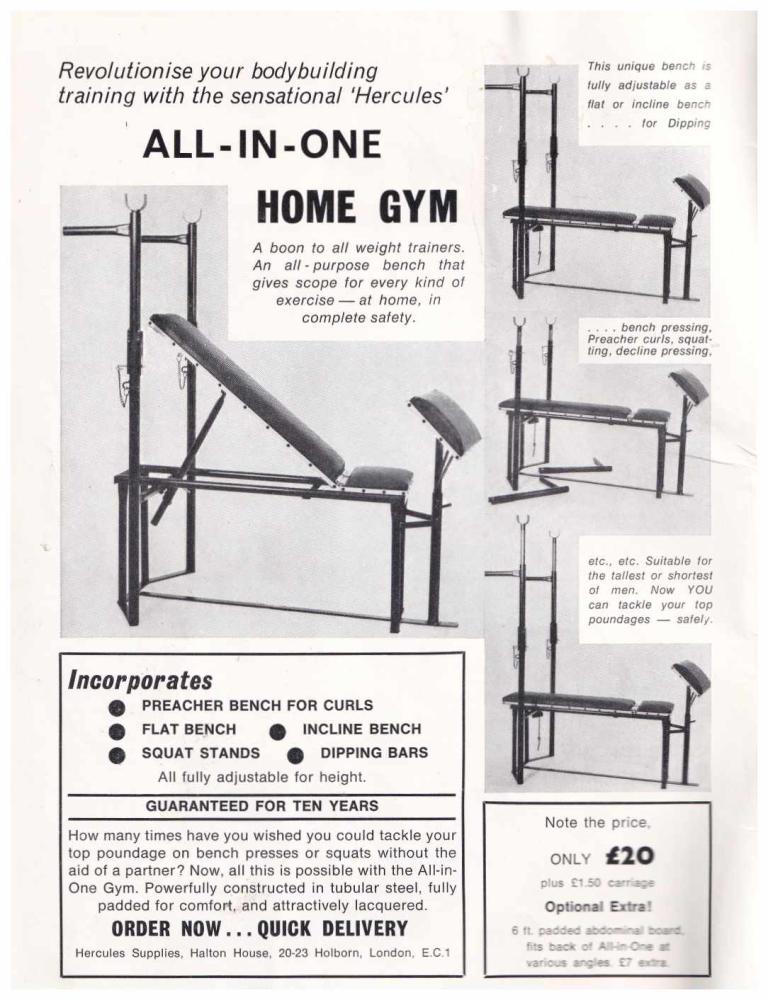
The All-In-One Hercules Home Gym advertisement from Health & Strength Magazine. Roger purchased this exact piece of gym equipment to take aboard the H.M.S. Hermes, the aircraft carrier vessel he was deployed on for active service.
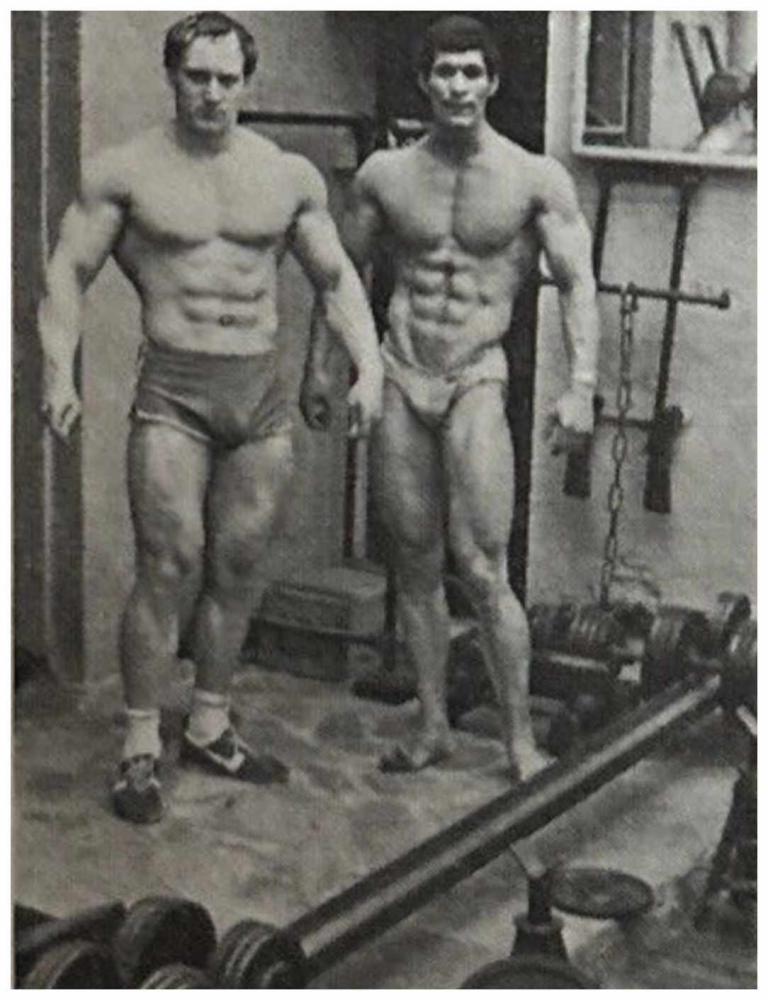
An early photo of Roger (circa 1970) with Roy Chavez. Roger was still in England at the time.
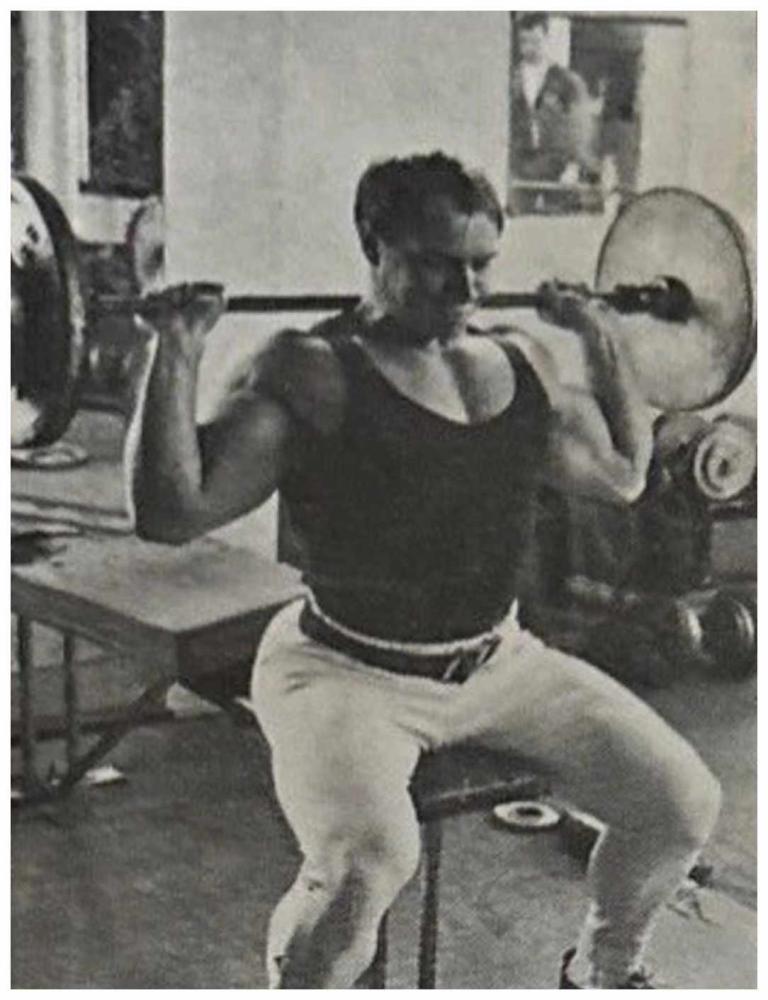
An early photo of Roger whilst still in England (Circa 1970). This training photo appeared in Wag Bennett’s Peak Muscle Maker magazine.
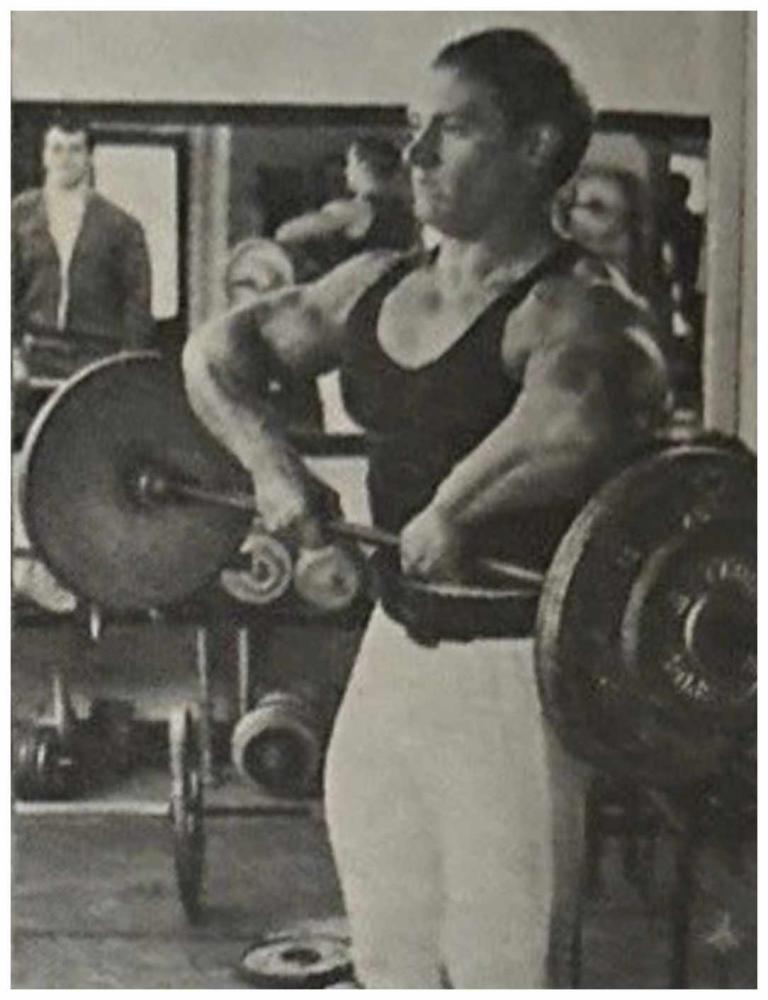
An early photo of Roger whilst still in England (Circa 1970). This training photo appeared in Wag Bennett’s Peak Muscle Maker magazine.
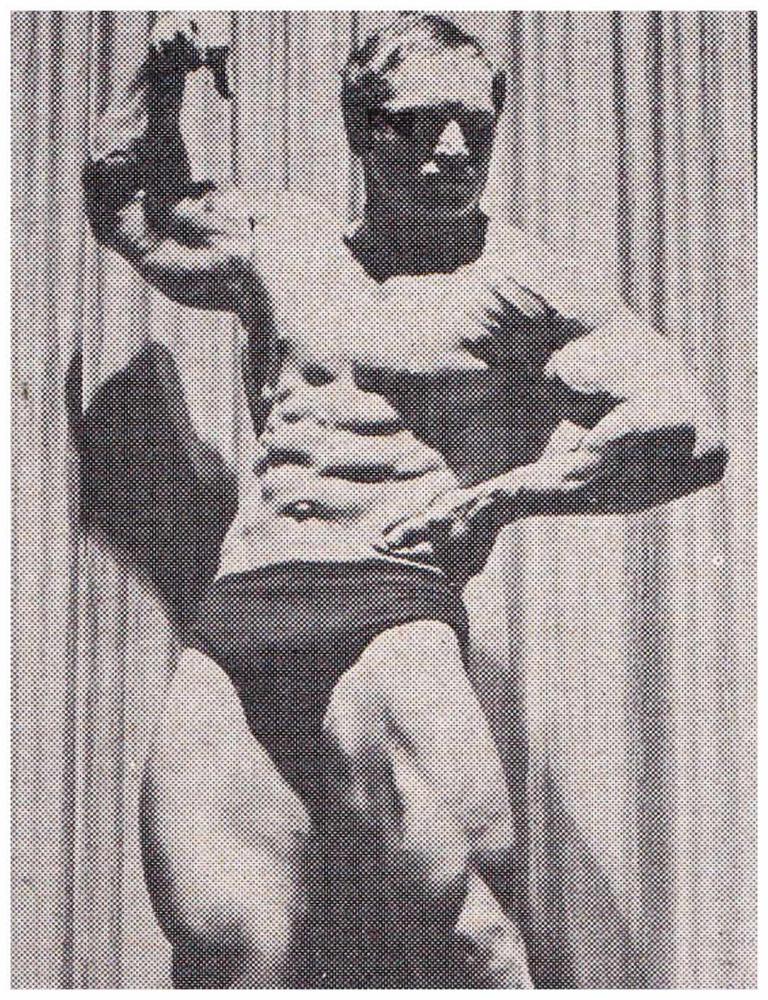
1972 IFBB Mr United Kingdom. Roger would win the contest ahead of John Citrone and Bill Richardson.
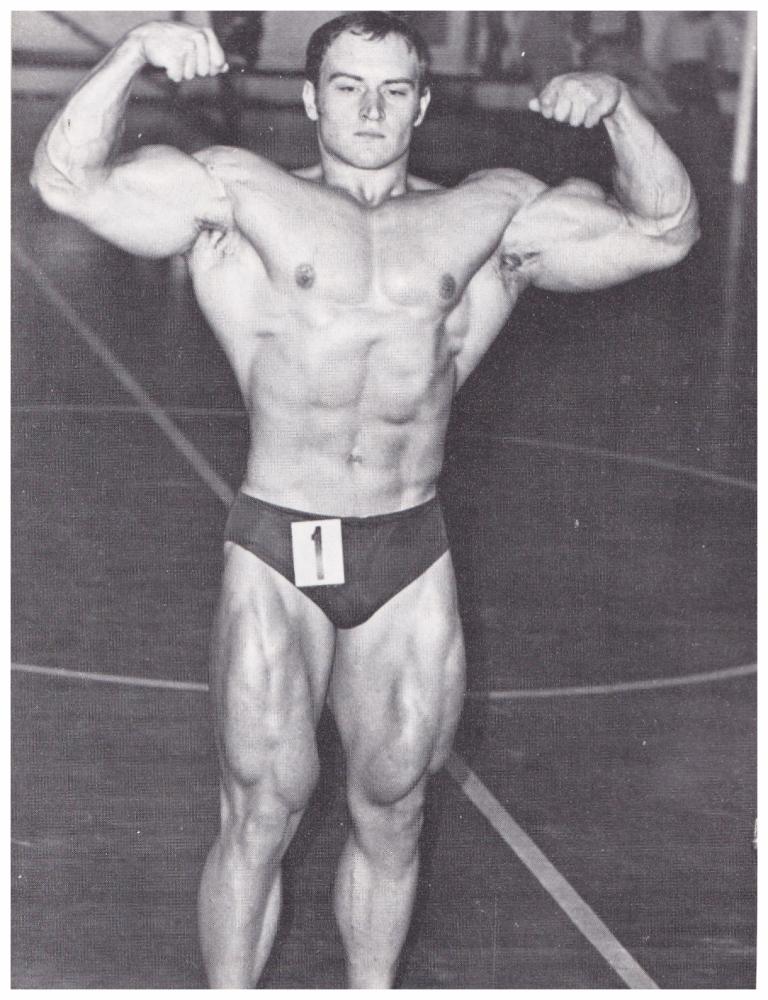
1973 Mr Australia. Rogers first contest on Australian soil. Roger would overcome the challenge of the impressive but highly enigmatic Victorian Clyde Bird, whilst Bill Richardson of Perth would take the third spot.
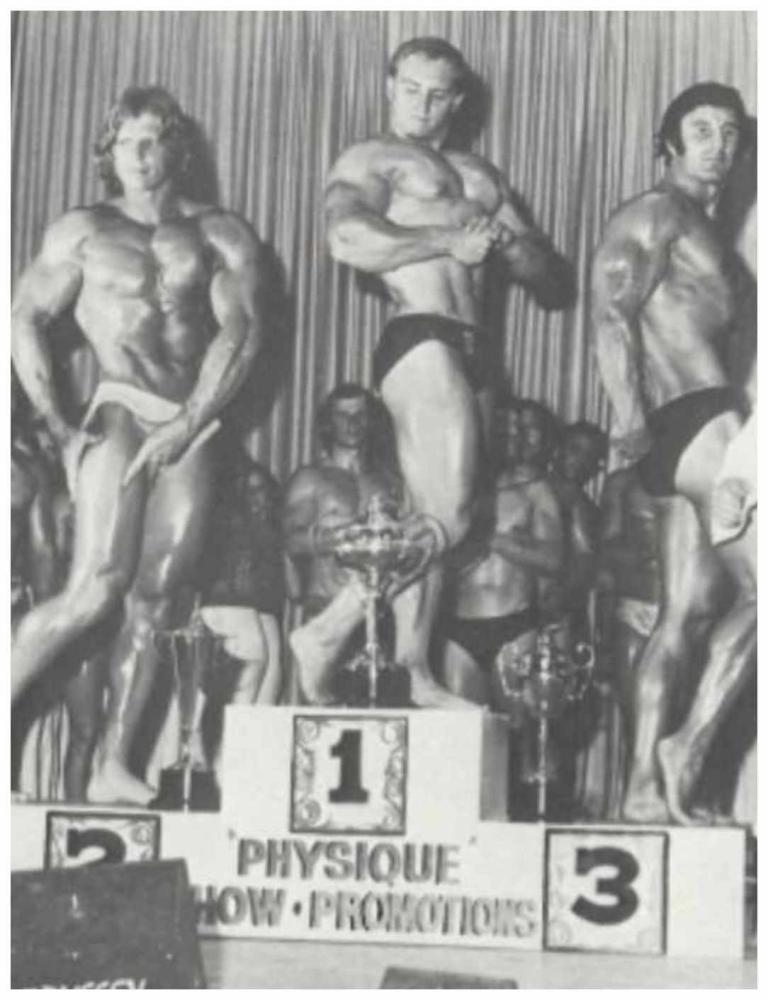
1973 Mr Australia. Roger Walker (1st), Clyde Bird (2nd), Bill Richardson (3rd)
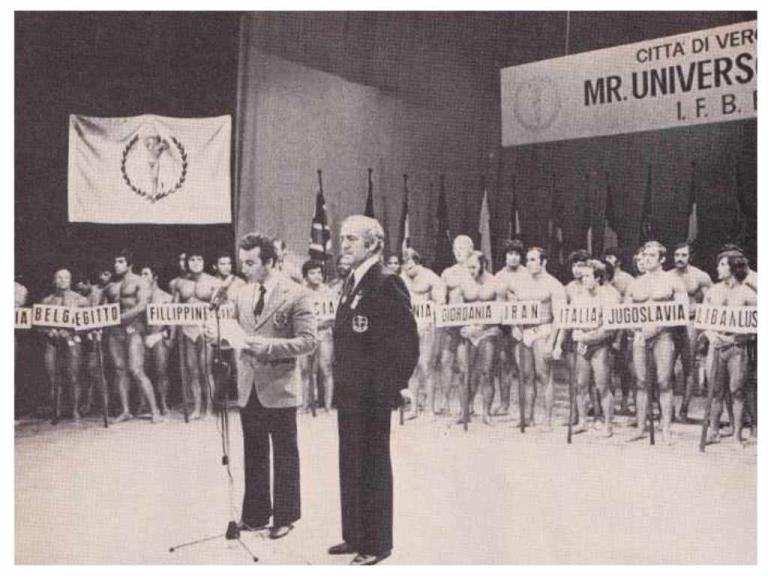
The 1974 IFBB Mr Universe opening ceremony. Roger is just outside the shot holding the Australian placard to the left of screen. He would ultimately finish 4th in class behind Lou Ferrigno.
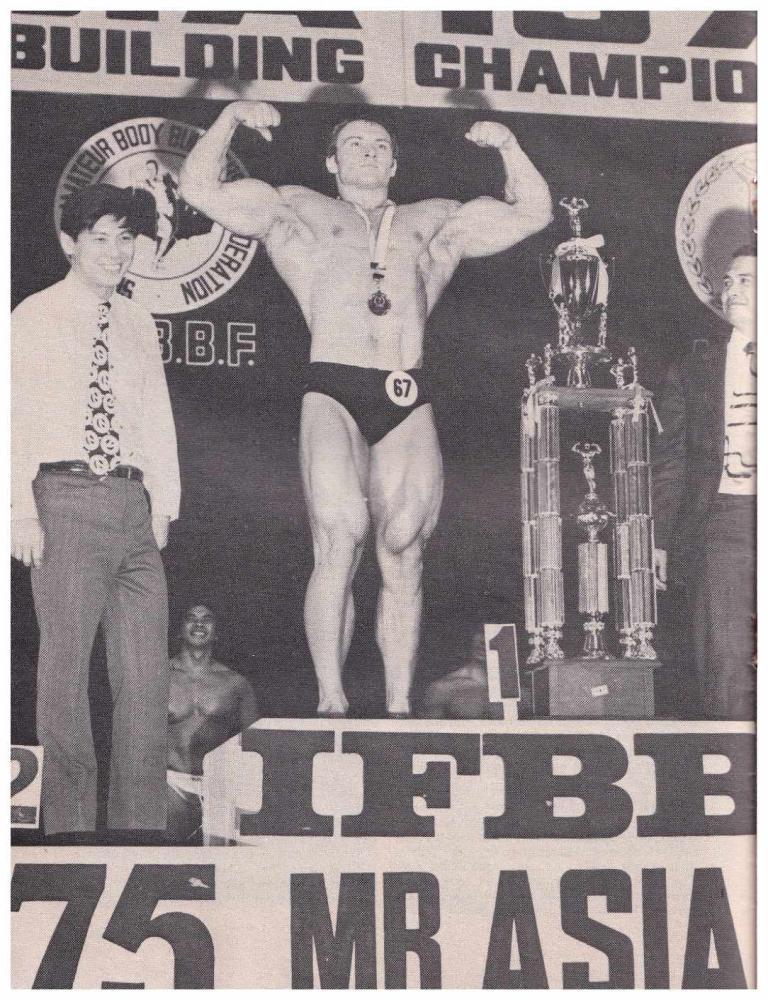
1975 Mr Asia winner Roger Walker. Unfortunately the trophy had to be left behind.
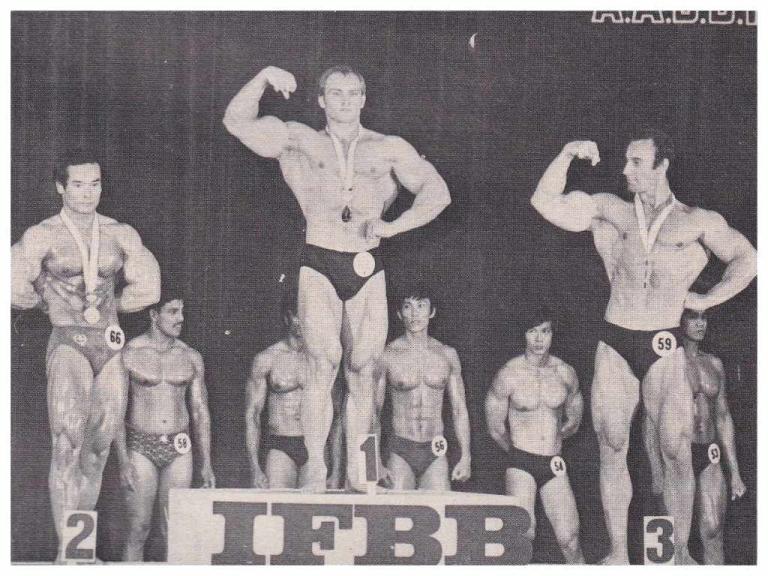
The 1975 Mr Asia Heavyweight Class winners. Roger won his class with his sheer size, symmetry and proportion ahead of the superb physique of Hideyuki Kosaki of Japan and fellow countryman Bill Robertson.
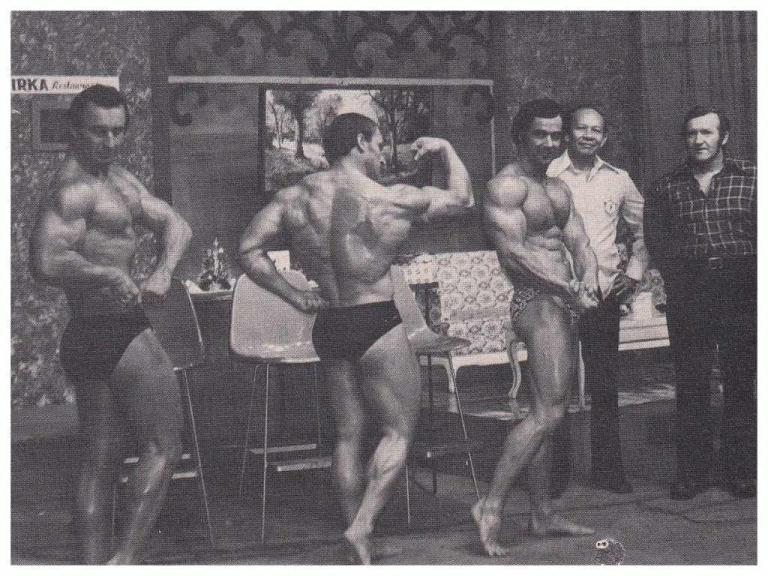
Manilla 1975. Bill Robertson, Roger Walker and Peter McCarthy posing on Pilipino television to an estimated audience of 4.5 million viewers. Frank Burwash left of screen looks on.
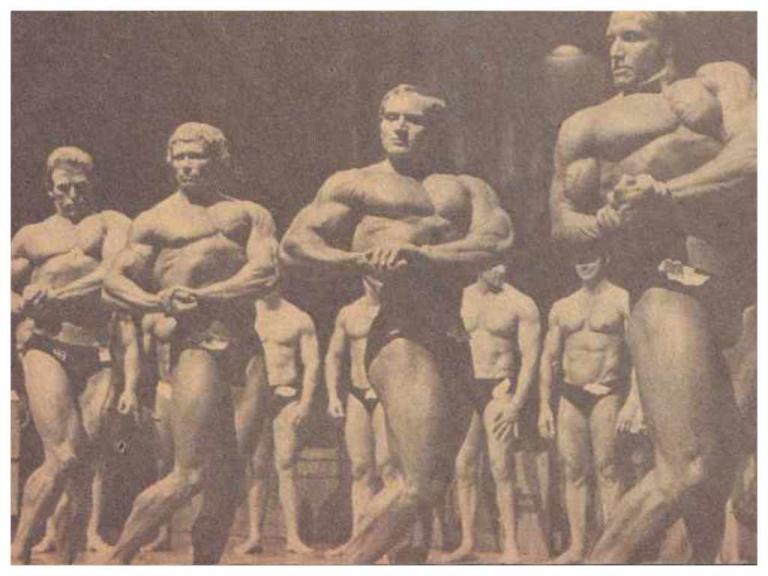
1975 IFBB Mr Universe tall class comparisons. Waller, Grant, Walker and Katz. Roger would finish 2nd a mere 3 points behind class and overall winner Ken Waller.
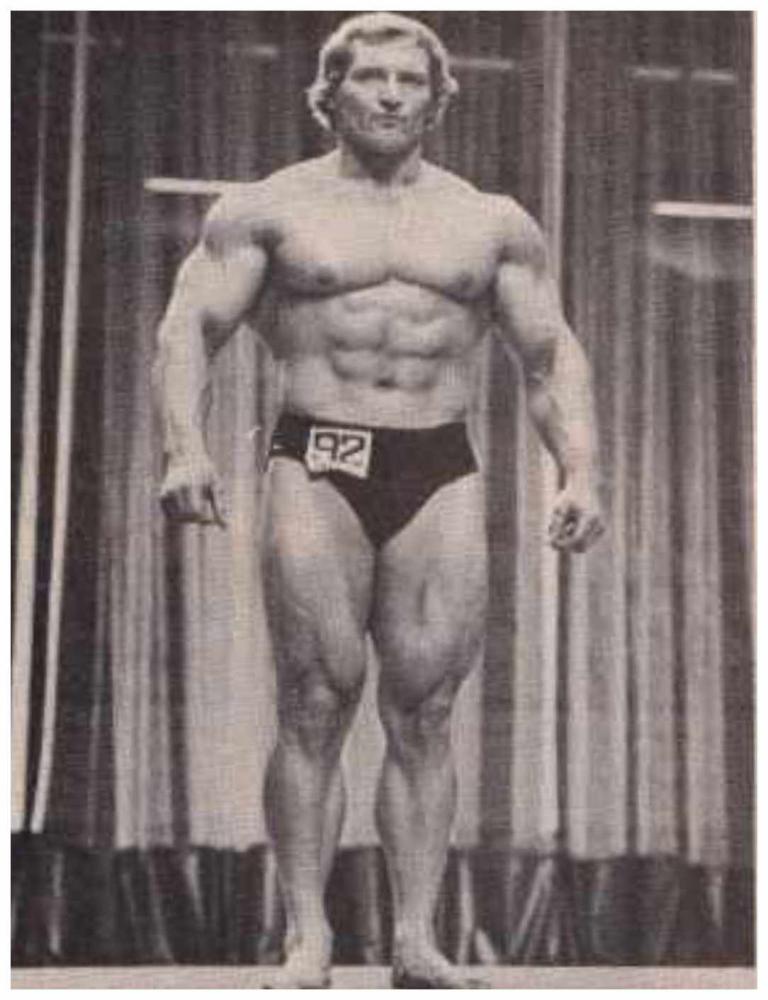
1976 IFBB Mr Universe Roger Walker! Roger was big at 220lbs and it was this size that was the critical factor that won him the title.
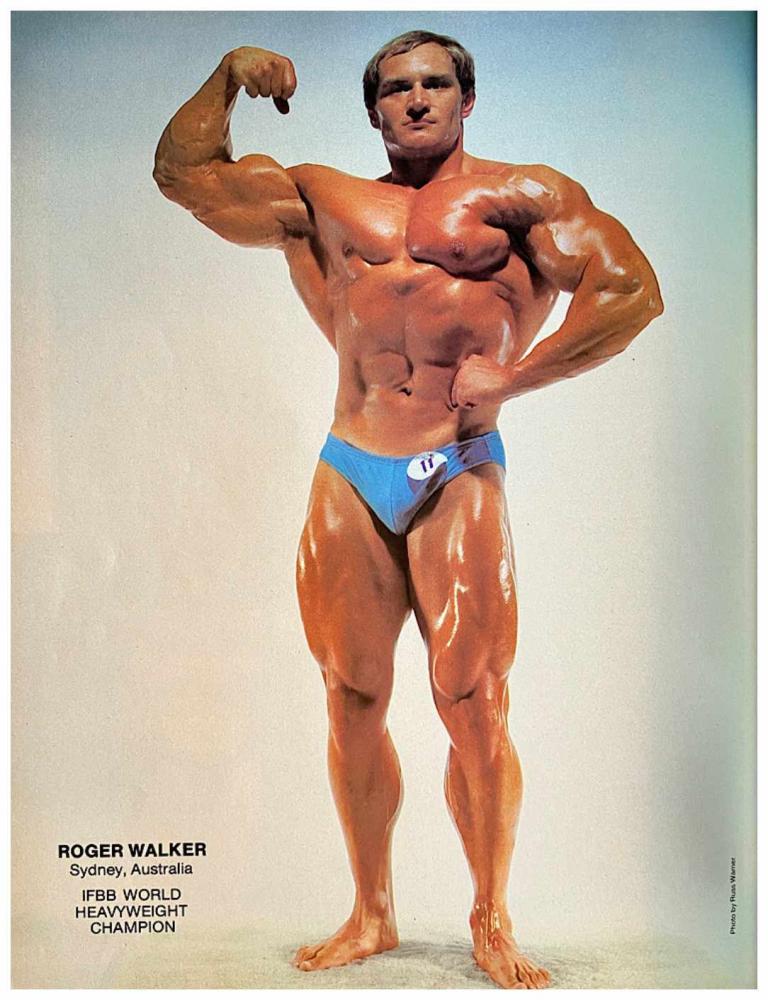
1976 IFBB Mr Universe Roger Walker.
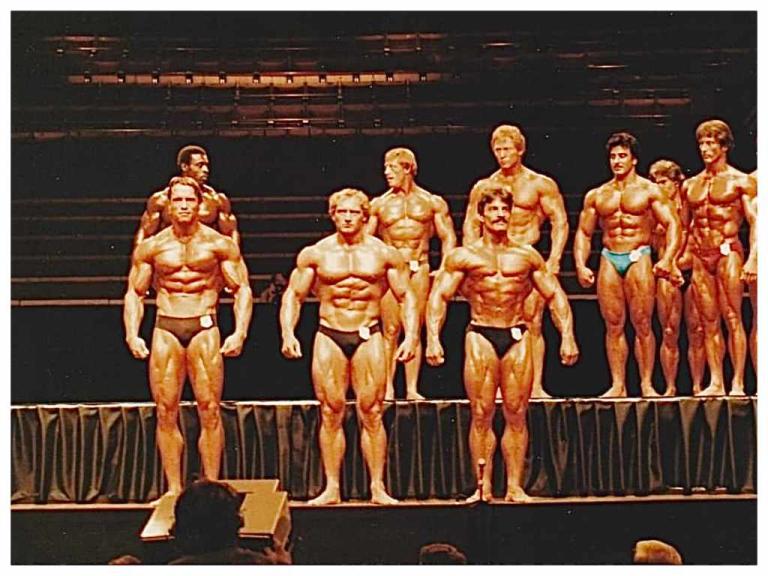
1980 Mr Olympia. Schwarzenegger (1st), Walker (6th) and Mentzer (5th). Walker, who looked in the best shape of his career, was standing alongside Arnold in the final pose down and compared quiet favorably to him in many of the poses. Roger received a tremendous reception from his hometown crowd. (Unpublished photo care of John Noonan)
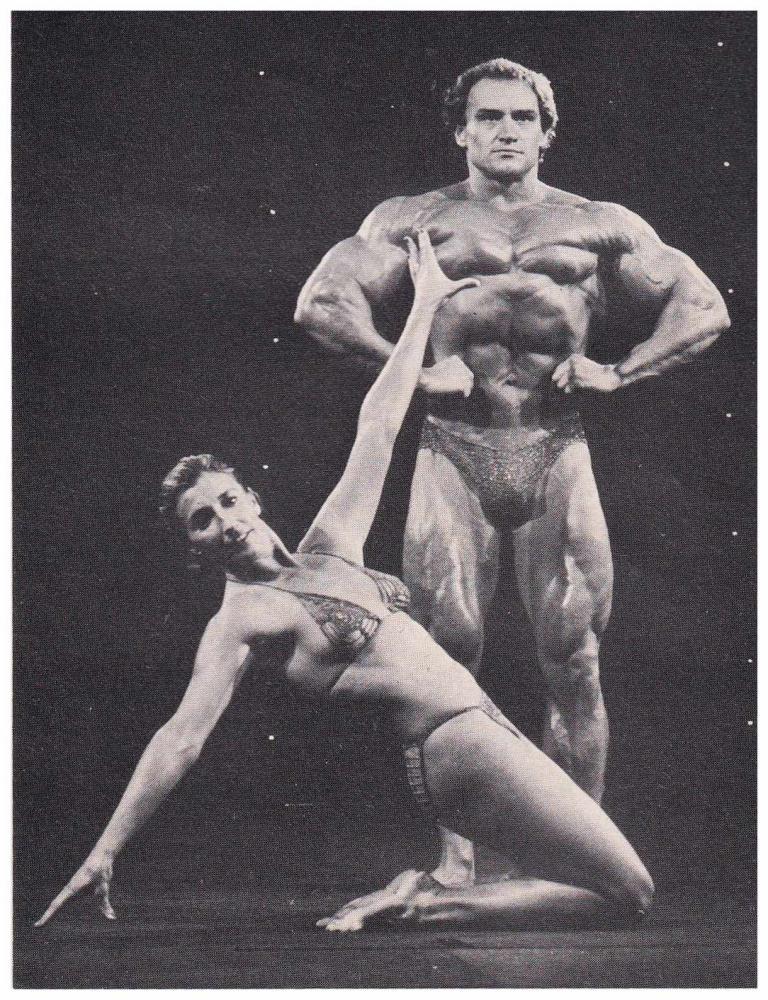
Roger Walker and Kim Rogers representing Australia at the 1981 IFBB World Couples Championships.
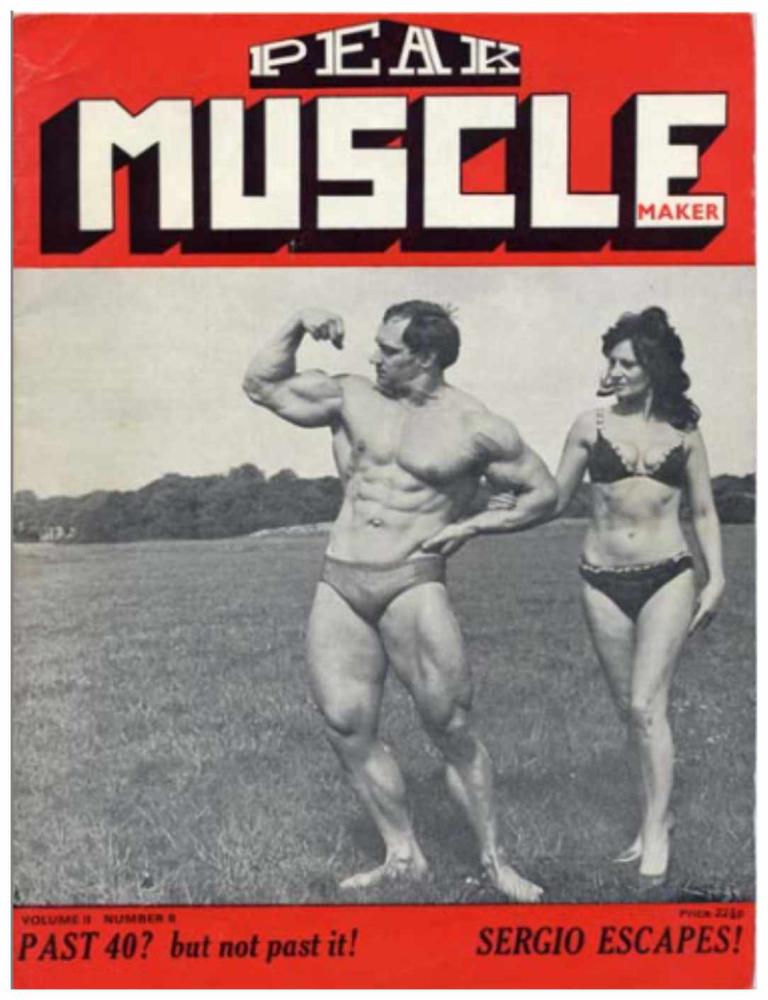
Roger Walker and Pauline Rawson on the cover of the January 1971 edition of Wag Bennett’s Peak Muscle Maker.
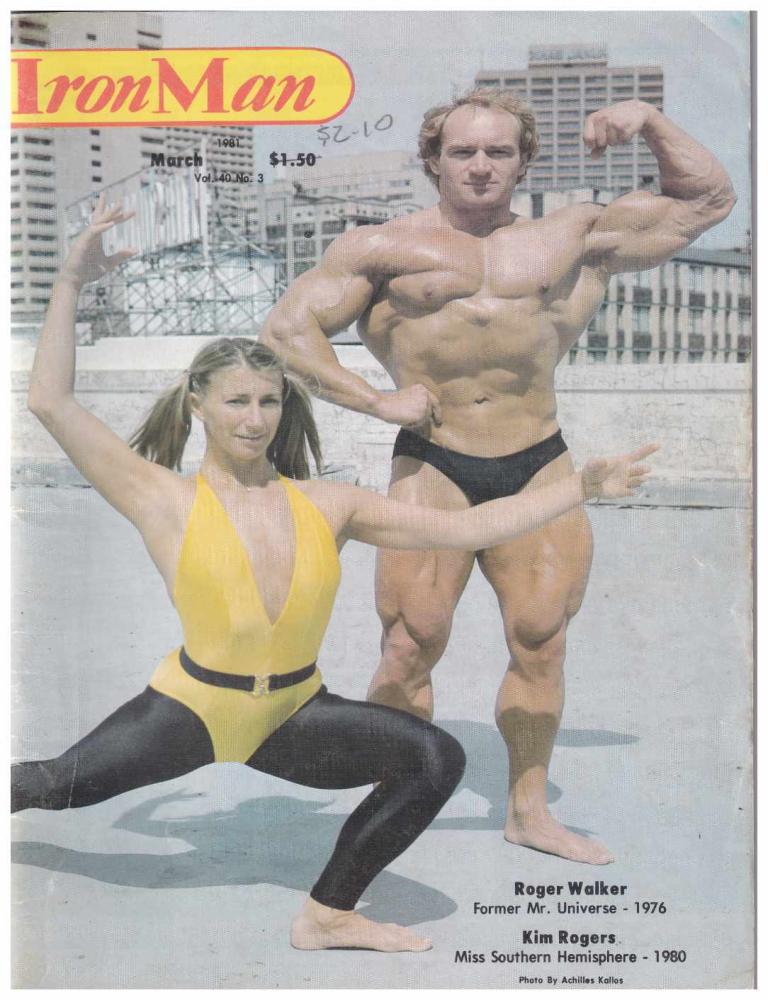
Roger Walker and Kim Rogers on the over of the March 1981 edition of IronMan.
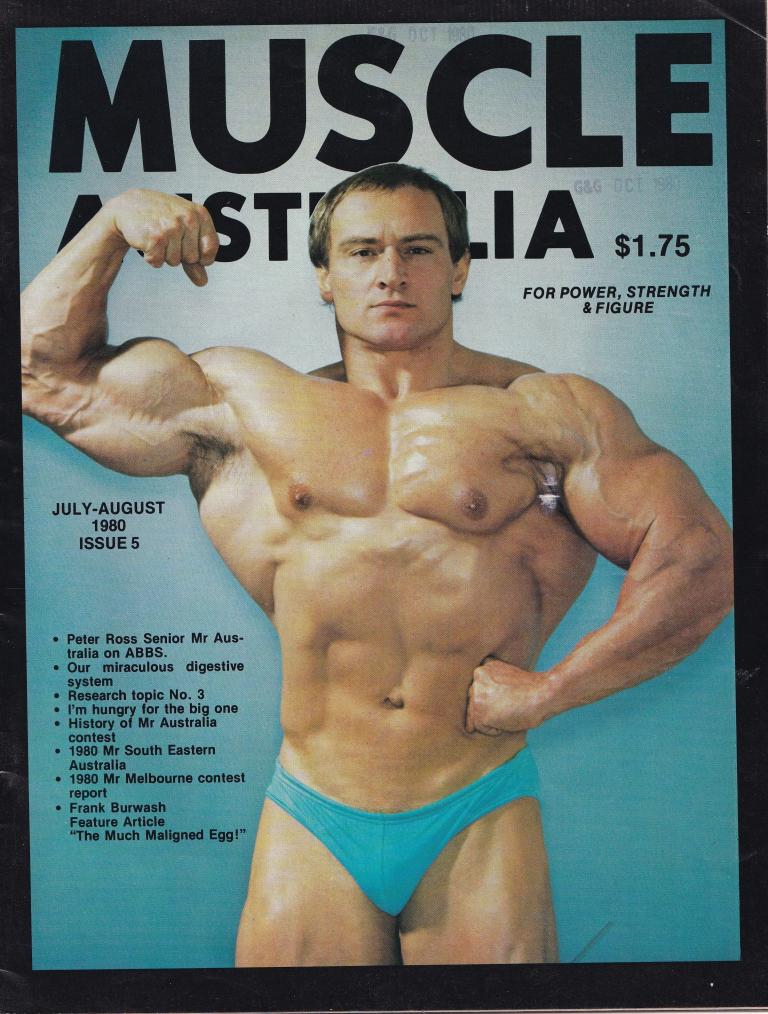
Roger on the cover of the August 1980 edition of Muscle Australia.
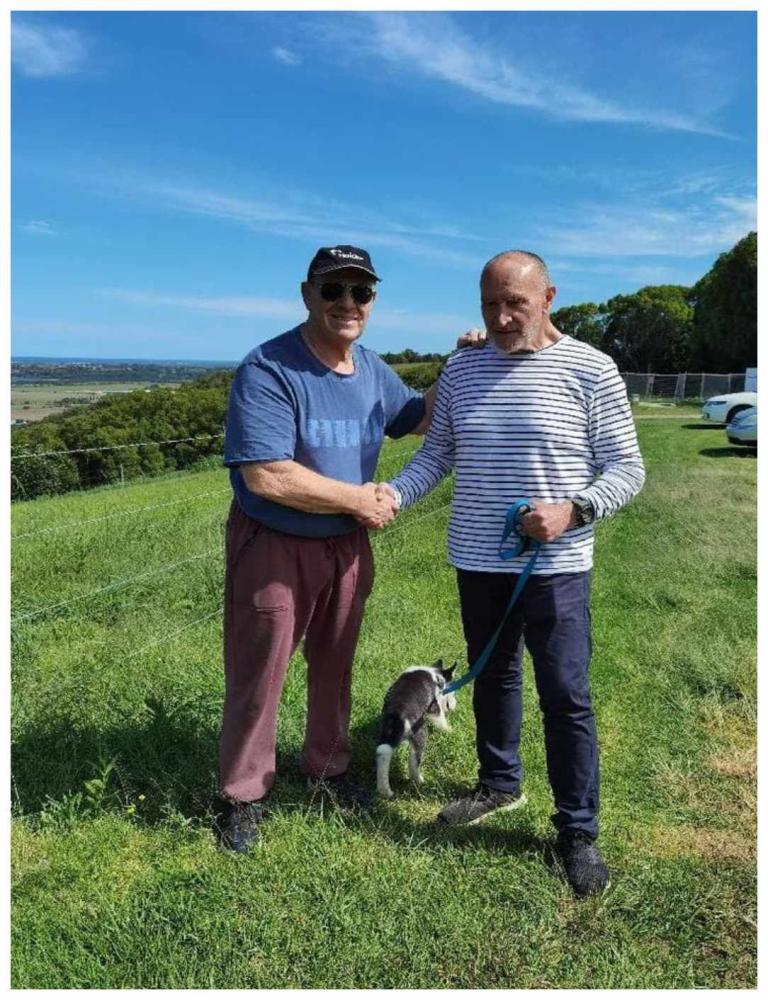
Recent photo with George Johns and Roger Walker. A friendship that exceeds 50 years!


